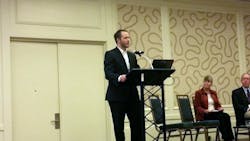At the American Public Transportation Association 2015 Annual Meeting in San Francisco, public transportation industry leaders come together to share ideas with their peers. One of the sessions focused on some of the best practices coming out of small operations.
GTrans Deputy Director of Transportation Paula Faust and Rock Region Metro Executive Director Jarod Varner shared their experiences of rebranding an agency and Monterey-Salinas Transit Assistant General Manager/Chief Operating Officer Mike Hernandez and Antelope Valley Transit Authority Executive Director Len Engel talked about their experience in operating all-electric vehicles.
Energized Engagement
Varner said that there were multiple things Rock Region Metro, formerly Central Arkansas Transit Authority, needed a service plan, needed a financial plan and needed options on how to fund this new vision.
They worked with consultants and began the process with two voter polls to get a feel for what people wanted and what the perceptions were. This helped in knowing the types of services the people wanted and what they would support. Varner said the voter polls were less time consuming and cheaper than community surveys.
Doing rebranding had multiple benefits. With a sales tax vote in March 2016, Varner said they wanted to elevate the agency’s profile. Rolling out the new brand and getting some new buses provided new technologies to the passengers, with Wi-Fi and real-time information.
Due to the engagement nature of the planning and rebranding, it’s often the same people coming together. Varner said they wanted to avoid engagement fatigue, so they were able to have fewer meetings to garner their input without wearing them out. Varner also added that including rebranding in strategic planning energized people.
"It All Starts with GTrans"
The former Gardena Municipal Bus Lines was known as GMBL to employees, though the community referred to it as “the green one,” “Gardena bus” and the “green and yellow bus.” Faust stressed, “No one knew our name.”
Faust said branding is all about appearance and Gardena was wrapped in 70s clothing. In 2015 the agency was celebrating its 75th anniversary so the staff wanted to capitalize on the timing.
The starting point was looking at what the personality of the system was. The creative brief captured all the elements that go in in the campaign; the creative brief drives the process.
One of the first tangible pieces of branding was the design and naming concepts. It was narrowed to 30 names and 20 design concepts, then they asked a small team to narrow it to 6 names and 7 design concepts. While initially operators didn’t want to change the name or look of their buses, once they were shown the designs, once they realized they had a say in final design and a say in the whole thing, once they knew their words were being brought forward to final designers and the city manager, their fears were diminished.
Something they didn’t see coming when they were looking for their tagline, they narrowed it to three phrases and one was “It’s a G Thing.” Faust said while the administrators all really liked it, once they started sharing the ideas with different departments of the city, they got some backlash, in particular from the parks and recreation and from the gang division in the police department. Faust said someone sent her a meme pointing out it was too close to gang affiliation.
“I can’t overemphasize how important focus groups are,” Faust said. “Employee groups are gems, just get a cross division.”
The tagline they decided on for the new GTrans is “It all starts with GTrans.”
She also stressed in the presentation that they couldn’t have done the process without their partners, including Pulsar Advertising.
All-Electric Trolley
A 2003 Optima trolley was run on a route from downtown Monterey, California, to Cannery Row for Monterey-Salinas Transit. Assistant General Manager/Chief Operating Officer Mike Hernandez said they had about 120,000 miles on it and it was sent to Complete Coach Works in Riverside, California, for a complete refurbishment.
WAVE Inc. and CCW turned the 2003 trolley into an all-electric trolley with Lithium ion batteries.
The total cost of the project was about $1.8M, with $1.6M coming from the Federal Transit Administration.
WAVE and CCW have the ability to dial in to the vehicle to see the real-time status of the vehicle, the charge and other information and there’s a Panasonic tablet that shows the operator when it is charging wirelessly.
There were four charging location options considered and due to the local power company’s schedule, it ended up across from a transit plaza. No matter what the construction project, there are things that will drive costs, said Hernandez. There was a junction box required in the sidewalk and the city of Monterey had to do some sidewalk improvements as well as move some lighting.
The charge efficiency is 98 percent and the remaining charge at the end of 20 laps is 31 percent.
Some of the challenges were the overall project delay because of PEPRA funding, getting a schedule from the local electrical company for the charging location and a training curve of the vehicle alignment and kneeling for the operators. There is an 8-inch air gap needed in a specific location.
They did a lot of testing early on and the next step is testing the trolley on other routes, Hernandez said.
With new technology, they weren’t sure what to expect, but the reliability turned out to be better than anticipated. Their direct costs has been about $1.08 per mile, including maintenance, Hernandez said. During the same time, the diesel was $1.85 per mile.
Complete Fleet
Antelope Valley Transit Authority Executive Director Len Engel said staff went to a board meeting asking to replace a number of older buses with replacement diesel buses and was told to never come back and ask for diesel; they were going all-electric.
The $39 million project provides for:
- 13 60’ battery-electric articulated buses
- 16 45’ battery-electric commuter coaches
- 11 primary 200+kW inductive chargers
- 34 secondary “receivers” on the bus
Engel said construction will begin within the next month on the on wave 50kW inductive charger and in January 2016, construction of phase 1 of the depot charging infrastructure project will begin.
There will be four inductive chargers at each of the transit centers. Current plan calls for additional chargers near Lancaster Metrolink station and southeastern Palmdale. There will also be depot charging at the barn.
There is 1.4 million available from local money to assist in development of the higher power chargers. Because of the extended miles that the buses operate, they needed the higher power for the energy we need.
When asked about the replacement plan for the batteries, Engel said the batteries are provided by BYD and there is an agreement that BYD buys them back when they hit 80 percent and are warrantied for 12 years.



